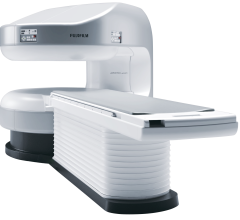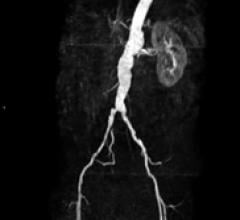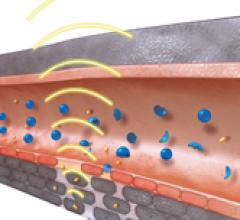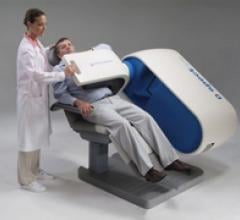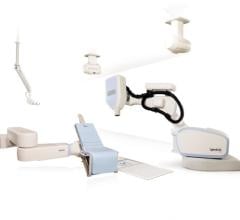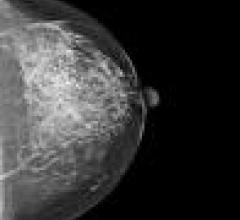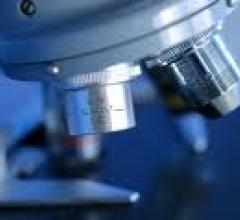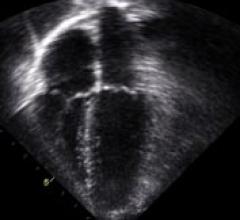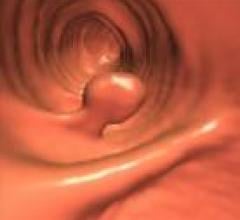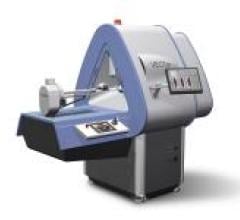June 7, 2010 - One of the biggest challenges in image-guided treatments is tissue location. To help guide visibility, new biocompatible pure gold implanted markers are designed to identify the location of normal or diseased tissue for future treatments, including image-guided radiation therapy (IGRT).
"Most people have no idea what a tremendous impact radiology and telemedicine have on poor and remote regions of the world," said Rebecca Cornelius, M.D., professor of radiology, neuroradiology, department of radiology, University Hospital, University of Cincinnati, College of Medicine.
June 4, 2010 – Speech understanding technology that accepts data and translates additional physician dictation in real time into a structured document was introduced yesterday at the Annual Meeting of the Society of Imaging Informatics in Medicine (SIIM) in Minneapolis.
Fujifilm’s APERTO Lucent is a 0.4T mid-field, open MRI system addressing today’s capability and image quality needs ...
June 4, 2010 – The first national contract signed for a magnetic resonance imaging angiography (MRA) contrast agent was been signed, making it available to more than 27,000 medical facilities.
June 4, 2010 – A monthly, online service was launched today that allows clinicians to review and interpret general and cardiac nuclear medicine studies from anywhere in the world for a low monthly rate. The Medx Web Viewer permits interpretation of any original equipment manufacturer (OEM) dataset with nuclear medicine-specific color tables and cine movie displays.

SPONSORED CONTENT — Fujifilm’s latest CT technology brings exceptional image quality to a compact and user- and patient ...
June 3, 2010 – A joint research agreement will explore the targeted delivery of experimental therapeutics based on ribonucleic acid (RNA) interference (RNAi). Philips Healthcare and RXi Pharmaceuticals Corp. say imaging compounds based on RNAi represent a promising new class of drugs for the targeted treatment of a number of diseases including cancer and cardiovascular disease.
SPONSORED CONTENT — Fujifilm’s latest CT technology brings exceptional image quality to a compact and user- and patient ...
June 3, 2010 – A single photon emission tomography (SPECT) system may significantly reduce patient and staff radiation exposure by using significantly less radioactive imaging agent.
Automated contrast media injectors are used in cardiac imaging to help improve patient safety and enhance image quality. These devices can control contrast dosage, record the amount used, speed injections to keep up with faster computed tomography (CT) scanners, and warn clinicians of potential hazards, such as air embolisms or extravasations.
In these challenging economic times, hospitals are seeking to maximize their investment in technology. To justify purchasing any imaging modality, such as computed tomography (CT), positron emission tomography (PET) or single photon emission computed tomography (SPECT), a facility has to have sufficient patient volume to pay for the investment.
SPONSORED CONTENT — EnsightTM 2.0 is the newest version of Enlitic’s data standardization software framework. Ensight is ...
A report from the American Heart Association Committee on cardiac imaging stated that between 1980 and 2006 the collective dose from medical uses of radiation received by the U.S. population increased by more than 700 percent.1 The report also indicated “[Cardiac computed tomography angiography] (CCTA) accounted for around 50 percent of the collective dose.2
One of the biggest challenges with tumor control is accelerated repopulation. Surviving tumor cells can repopulate after a few fractions of radiation are delivered or during intervals between treatments. To make matters worse, the rate of tumor repopulation accelerates after each successive treatment.
June 3, 2010 - The time to deliver a radiosurgery plan may be reduced by up to 50 percent, while maintaining accuracy, compared to the hybrid radiotherapy systems at the Creekside Cancer Care center in Lafayette, Colo.
Did you know that approximately one-third of all the data in world is created by the healthcare industry and that ...
June 3, 2010 - On May 26, WellPoint announced it will implement certain provisions of the Breast Cancer Patient Protection Act (HR 1691), which aims to standardize minimum guidelines for care for women with breast cancer, although the bill is not yet law.
June 3, 2010 - "Physician productivity disparities are not uncommonly debated within radiology groups, sometimes in a contentious manner," stated the authors of a new study published in the June issue of the Journal of the American College of Radiology.
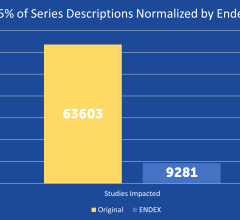
SPONSORED CONTENT — EnsightTM 2.0 is the newest version of Enlitic’s data standardization software framework. Ensight is ...
June 3, 2010 - The CTC Coalition, consisting of physician providers, colon cancer patient advocates and imaging technology manufacturers, today announced their support for H.R. 5461, a new bill to cover computed tomography colonography (CTC), commonly known as virtual colonoscopy.
June 3, 2010 - More than 70,000 people in the U.S. were diagnosed with cancer of the bladder in 2009, with an estimated 14,000 people dying from the disease, according to the National Cancer Institute. The disease is difficult to detect, and the most common, initial sign is red-colored urine, which calls for urine cytology and cystoscopy.
June 2, 2010 – Key research on new diagnostic uses for cardiac ultrasound will be presented at the American Society of Echocardiography (ASE) 21st Annual Scientific Sessions June 12-15, in San Diego. Leading experts in cardiology will present and discuss the latest clinical and research developments in adult and pediatric echocardiography. Among the key presentations are:
June 3, 2010 - Positron emission tomography (PET) combined with computed tomography colonography (CTC) may provide a suitable alternative for detecting polyps and cancer in the colon and does not require sedation or bowel preparation, according to a study published in the June issue of The Journal of Nuclear Medicine.
June 2, 2010 - TU Delft and Molecular Imaging Labs (MI Labs) have succeeded in combining two forms of medical imaging techniques into one piece of equipment. The two techniques are known as micro positron emission tomography (microPET) and micro single photon emission computed tomography (microSPECT).
June 2, 2010 - Elekta AB, a Swedish Medical technology company, announced June 1, it acquired oncology imaging developer Resonant Medical Inc. of Montreal, Canada, for $30 million in Canadian dollars.

 June 06, 2010
June 06, 2010 


